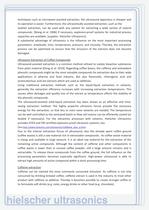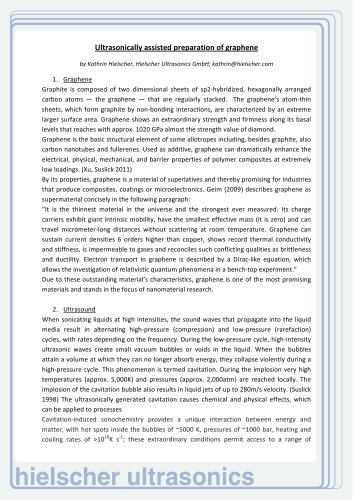
Catalog excerpts

Using Ultrasonics in Coffee Processing: The Extraction of Caffeine and other Active Compounds Kathrin Hielscher, Hielscher Ultrasonics GmbH, kathrin@hielscher.com Coffee – made from roasted coffee beans - is a very popular drink that is worldwide consumed. Besides to its vitalizing impact if consumed as a stimulant drink, the compounds of coffee are of interest for the food, pharmaceutical (e.g. in pain relievers) and cosmetic industry as used as valuable additives in various products. This applies especially for the caffeine (1,3,7-trimethylxanthine) and the antioxidants, which are known for their positive effects on the human health. Coffee contains, amongst others, phenolic diterpenes such as cafestol and kahweol, and ascorbic acids, which are known for their antioxidative activity. Epidemiological studies suggest that coffee’s ingredients may have a preventive effect on several chronic diseases, including type 2 diabetes mellitus, Alzheimer’s disease, Parkinson’s disease, and liver diseases such as cirrhosis and hepatocellular carcinoma. Ultrasonics is a well known and proven tool for many different applications in various industries. A very successful application is the ultrasonic extraction. Thereby, the ultrasonic cavitation effects on the cell material causing cell disruption and the release of the intracellular matter. Ultrasound To ensure a more easy understanding of the ultrasound assisted extraction procedure, the effect of ultrasound in liquids must be explained. Ultrasound - introduced in liquids - causes locally very extreme effects. When sonicating liquids at high intensities, the sound waves that propagate into the liquid media result in alternating high-pressure (compression) and low-pressure (rarefaction) cycles, with rates depending on the frequency. During the low-pressure cycle, high-intensity ultrasonic waves create small vacuum bubbles or voids in the liquid. When the bubbles attain a volume at which they can no longer absorb energy, they collapse violently during a high-pressure cycle. This phenomenon is termed cavitation. During the implosion very high temperatures (approx. 5,000K) and pressures (approx. 2,000atm) are reached locally. The implosion of the cavitation bubble also results in liquid jets of up to 280m/s velocity. [Suslick 1998] By these extreme forces sonolysis occurs, cell walls are disrupted, and intracellular material is extracted. The ultrasonically assisted extraction is an inexpensive, simple and efficient alternative compared to conventional extraction techniques. The main advantages of ultrasound in solid–liquid extraction include the increase of extraction yield and faster kinetics. Ultrasonic extraction is a frequently used technique for the extraction of plant materials using liquid solvents and is proven for a fast and more complete extraction process in comparison with traditional methods because the surface area between the solid and liquid phase is significantly larger due to the cell disruption and particle dispersion. By the use of sonication also the operating temperature can be reduced, allowing the extraction of temperature-sensitive components. Compared with other novel extraction
Open the catalog to page 1
techniques such as microwave-assisted extraction, the ultrasound apparatus is cheaper and its operation is easier. Furthermore, the ultrasonically assisted extraction, such as the Soxhlet extraction, can be used with any solvent for extracting a wide variety of natural compounds. [Wang et al. 2006] If necessary, explosion-proof systems for industrial process capacities are available. [supplier: Hielscher Ultrasonics] A substantial advantage of ultrasonics is the influence on the most important processing parameters: amplitude, time, temperature, pressure, and viscosity. Thereby, the...
Open the catalog to page 2
But caffeine is not only used as additive in the food production, it is an important active compound in pharmaceuticals as well. A common application of caffeine extract is e.g. the admixture in drugs for headache and migraine or in pain relievers. To extract caffeine, the main alkaloid in coffee, ultrasonication is a suitable method. Wang and his colleagues [Wang et al. 2011] found that only a short extraction time is needed to reach a saturated state, if ultrasonication is used. This means that ultrasound a very efficient and time saving technique for gaining caffeine. Aromatic and...
Open the catalog to page 3
Cao, Chuanhai; Wang, Li; Lin, Xiaoyang; Mamcarz, Malgorzata; Zhang, Chi; Bai, Ge; Nong, Jasson; Sussman, Sam; Arendash, Gary (2011): Caffeine Synergizes with Another Coffee Component to Increase Plasma GCSF: Linkage to Cognitive Benefits in Alzheimer’s Mice. Journal of Alzheimer’s Disease 25/2, 2011. 323-335. Dong, Juane; Liu, Yuanbai; Liang, Zongsuo; Wang, Weiling (2010): Investigation on ultrasound-assisted extraction of salvianolic acid B from Salvia miltiorrhiza root. Ultrasonics Sonochemistry 17/1, 2010. 61-65. Herrera, M.C.; Luque de Castro, M.D. (2005): Ultrasound-assisted extraction...
Open the catalog to page 4All Hielscher catalogs and technical brochures
-
Ultrasonic Process Lab
1 Pages
-
Ultrasonic Wire Cleaning
4 Pages
-
Ultrasonic Applications
1 Pages
-
Hielscher Ultrasonic Sieves
2 Pages



















